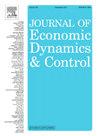Portfolio choice analysis in a multi-country macro model
IF 2.3
3区 经济学
Q2 ECONOMICS
引用次数: 0
Abstract
This paper examines portfolio choice in a dynamic stochastic general equilibrium model with trade and financial linkages across 43 countries. I conduct comparative statics analysis with this structural model to disentangle potential mechanisms of global financial allocation, including risk hedging, risk diversification, risk sharing, and financial friction. For asset home bias, the model predicts that risk hedging is less essential in a multi-country than in a two-country setting. For bilateral asset positions, the model implies that variations in financial friction and asset covariance are major determinants of observed cross-country portfolios. Meanwhile, bilateral financial linkages strongly covary with trade linkages across countries. Comparative statics suggests that this covariance is mainly driven by the high correlation of frictions across the two channels of globalization.
多国宏观模型下的投资组合选择分析
本文研究了43个国家的动态随机一般均衡模型中具有贸易和金融联系的投资组合选择。我利用这一结构模型进行比较静态分析,梳理全球金融配置的潜在机制,包括风险对冲、风险分散、风险共担和金融摩擦。对于资产母国偏好,该模型预测,在多国环境下,风险对冲不如在两国环境下那么重要。对于双边资产头寸,该模型表明,金融摩擦和资产协方差的变化是观察到的跨国投资组合的主要决定因素。与此同时,双边金融联系与各国之间的贸易联系密切相关。比较统计表明,这种协方差主要是由全球化两个渠道之间的摩擦的高度相关性所驱动的。
本文章由计算机程序翻译,如有差异,请以英文原文为准。
求助全文
约1分钟内获得全文
求助全文
来源期刊

Journal of Economic Dynamics & Control
ECONOMICS-
CiteScore
3.10
自引率
10.50%
发文量
199
期刊介绍:
The journal provides an outlet for publication of research concerning all theoretical and empirical aspects of economic dynamics and control as well as the development and use of computational methods in economics and finance. Contributions regarding computational methods may include, but are not restricted to, artificial intelligence, databases, decision support systems, genetic algorithms, modelling languages, neural networks, numerical algorithms for optimization, control and equilibria, parallel computing and qualitative reasoning.
 求助内容:
求助内容: 应助结果提醒方式:
应助结果提醒方式:


